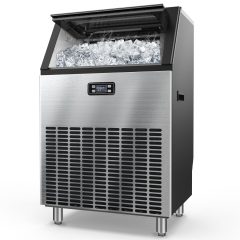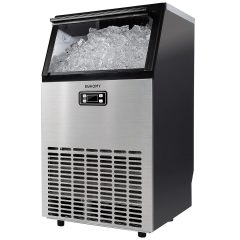BestReviews is reader-supported and may earn an affiliate commission. Details

This large-scale commercial ice machine can produce up to 265 pounds of ice per day.
Powerful compressor allows for this ice machine to rapidly produce large amounts of ice. Insulated storage bin can hold 48 pounds of ice. Built with heavy-duty stainless steel for a durable and easy-to-clean machine. Includes scoop and necessary installation hoses.
This machine produces very large sheets of ice which can be difficult to break apart.

A large-capacity commercial ice maker with an easy-to-use LCD panel.
Change settings, ice thickness, auto-cleaning, and timed ice with the automatic LCD display. Can produce up to 160 pounds of ice in 24 hours. Can make a sheet of ice in only 20 minutes. Storage bin can hold up to 35 pounds of ice at a time. Compact design suitable for homes or restaurants.
Ice in the storage bin tends to melt quickly.

With a heavy-duty compressor, a self-cleaning feature, and options for cube size, this machine gets our cooking expert's approval.
Produces 99 pounds of ice every day, making it an excellent choice for businesses. Requires no complicated tools or equipment to install. The self-cleaning mechanism only takes 20 minutes. All controls are clearly labeled on the LED screen.
Does not freeze the ice once it comes out, so users will have to pick it up straight away.

This stainless steel commercial ice maker can fit under a counter making it ideal for a bar, small restaurant, or home.
Under-counter ice maker can produce ice in only 11 minutes. The auto-cleaning feature takes the fuss out of maintenance. Customizable ice thickness and timed ice-making functions. Can produce 99 pounds of ice in a day and store up to 33 pounds at a time.
This machine is loud when producing ice and when the ice drops.

We recommend these products based on an intensive research process that's designed to cut through the noise and find the top products in this space. Guided by experts, we spend hours looking into the factors that matter, to bring you these selections.
Considered
Consulted
Researched


Buying guide for Best commercial ice makers
Taking a sip from an ice-cold beverage is refreshing and satisfying. Whether it’s sweet tea, soda, or a mixed drink, one ingredient stays constant: ice. Time is of the essence, though, when it comes to the cooling agent of our favorite beverages. It takes time to drive to the store for a bag of ice or wait for tap water to freeze in little ice trays.
Thanks to commercial ice makers, the wait for an ice-cold drink is no more. These efficient appliances are for genuine beverage aficionados who refuse to compromise on beverage temperature. They’re also gaining traction as one of the hottest home appliances due to their affordability and convenience. Commercial ice makers make ice quickly, with some churning out the first cubes in about 10 minutes. We reviewed some of the coolest ones on the market today to help you get the cubes you deserve.


Key considerations
Space
Commercial ice makers take up considerable space, though they’re designed to be neatly tucked away. Depth-wise, they don’t stick out much farther than a kitchen counter. Many are made to be installed into cabinets or walls, just like dishwashers or ovens. If you don’t plan to put it in either of those places, make sure it’s against a wall with an available water line and power outlet.
Output speed
Output speed drives purchase decisions for one simple reason: when you want ice, you don’t want to wait for it. Commercial ice makers with smaller outputs make about three pounds per hour, whereas larger-output models can make four or more pounds per hour. Regardless of hourly output, each model varies when it comes to the speed of the first churn, or how quickly the first ice cubes are produced. Some take as little as ten minutes, but some take closer to 30 minutes.
When shopping for an ice maker, output speed is expressed in three ways: how long it takes for the first cubes to produce, how much it produces in an hour, and how much it can produce in 24 hours. Mathematically speaking, these time periods are relative, but if you can compare them side-by-side with the same unit of measurement, it could help you isolate your selection.
Bin capacity
The bin capacity of a commercial ice maker measures how many ice cubes it can hold at maximum capacity. Keep in mind it doesn’t refer to a frozen compartment that stores ice after it’s made. The ice will eventually melt, but luckily, ice makers are efficient enough to pull the water through the reservoir again to make a new batch of ice. If the ice maker keeps running, it will maintain maximum capacity as the freezing and melting cycle continues. On average, the commercial ice makers in this category have bin capacities between 80 and 150 pounds.
Type of use
What do you intend to do with your ice maker? If you’re using it to have ice for a few drinks a day, a smaller ice maker is ideal. If you expect to host guests on a regular basis at your home, investing in a larger one is a better choice. Small business or office use could go either way, depending on staff size. At the restaurant level, you’ll definitely want a larger model.
Warranty
When it comes to commercial ice makers, a substantial warranty can provide peace of mind. Every warranty is different, though, so do your homework to find out the details about what’s covered as far as parts and repairs go. Some manufacturers directly ship components for you to replace on your own, and others have partnerships with preferred vendors for more complicated repairs and service. For service-driven warranties, it’s important to see who the manufacturers choose as vendors. If they’re not in your immediate service area, it could take an extended amount of time before someone can come to your home or office.
Features
Custom settings
Basic commercial ice makers simply produce ice, and they stop producing when they reach capacity. More advanced models have custom settings, including timers, energy-efficient modes, and desired output volume. Some models also feature dedicated timers to initiate self-cleaning cycles.
Self-cleaning
Because a commercial ice maker is an appliance — and a sizable investment — regular maintenance and cleaning are required. Some commercial ice makers are outfitted with self-cleaning cycles, and certain manufacturers sell compatible cleaning products. It’s important to have a maintenance schedule for your ice maker, as some manufacturer warranties could be negated due to cleaning and repair negligence.


Commercial ice maker prices
Commercial ice makers range from $450 to $2,000. Price really depends on the level of custom settings and quality of internal components.
Inexpensive
Models at the low end of the range, between $450 and $600, usually have limited timer or cleaning settings but are decent performers.
Mid-range
These units, between $600 and $900, are constructed with better materials and tend to have more custom settings options. These models are ideal for those who entertain in their homes, and businesses that want to boost their break room appliance offerings.
Expensive
Pushing the $1,000 to $2,000 range are the highest-output commercial ice makers. These upscale models are more efficient and can produce ice for prolonged periods of time. They’re geared toward restaurants and large cafeterias.
Tips
- Use the scoop. Whenever possible, use an ice scoop for machines where you can’t pull out the ice tray. Avoid putting glasses directly into the machine to get ice, as they could shatter. It’s also more sanitary, since reused glasses can bring contaminants inside the ice maker.
- Get extension cords. The power cord for some portable models may run short, so invest in an extension cord. Be sure to keep the cord out of the way of foot traffic. If it’s on the floor, either tape it down or secure it against the wall.
- Give it appropriate space to operate. Make sure the vents of your ice maker are not pushed against a wall or other appliance. They should be free and clear allow for airflow.
- Account for noise. If you’d like ice for smoothies or cold beverages in the morning, you may wish to use your ice maker the day before and store ice in your freezer. Some commercial ice makers are louder than others, which could wake up people in your home.
- Make a lot and save for later. Make a considerable amount of ice and store it in your freezer. That way, you’ll always have some on hand and won’t have to wait for the ice maker to make it.
- Think about long-term placement. If you think you’ll be using ice every day, make permanent space for it. Commercial ice makers can be compact, but they do have some weight to them. Finding a permanent home for your ice maker will save you from lugging it between areas.
- Consider the cost of fixing the refrigerator ice maker. If the price to fix your refrigerator ice maker is too steep between parts and labor from an appliance professional, a countertop ice maker is a cost-effective alternative.


FAQ
Q. Do I have to use filtered water for my commercial ice maker?
A. It’s not necessary, but some people say they notice a difference in the ice’s taste and clarity when using filtered water. Certain models come with a rudimentary internal filter as well, which needs to be changed periodically to maintain optimal ice and water quality.
Q. I’m having an outdoor party. Can I use my commercial ice maker outside?
A. Technically you could but check to see the preferred conditions for the model you have. Some commercial ice makers are well-suited for outdoor use, as they’re not affected by ambient temperature, whereas others are most efficient indoors in climate-controlled spaces.
Q. I didn’t fill up my commercial ice maker to full capacity, and I know it can hold more weight. Is it all right to put my beer cans and wine bottles in it?
A. Probably not, considering it’s an easy way to contaminate the rest of the ice around it. It’s also hard to know whether you’ve added too much weight to the bin with ice already in it, so it’s best to simply use your unit for ice to serve with your beer and wine.
Q. I just sold my home. Can I take my commercial ice maker with me?
A. Provided it was not included with the sale of your house, yes. All you have to do is disconnect the water and power. Make sure it is properly packed and secured in the moving truck, especially since it’s stainless steel and could be dented if it’s not wrapped in some way.
- Best Cloth Napkins
- Best Kitchen Linen Sets
- Best Kitchen Table Pads
- Best Kids' Cups
- Best Kids' Plates
- Best Dish Towels
- Best Bridal Drinkware
- Best Cocktail Smokers
- Best Novelty Ice Pop Molds
- Best Gas Range Protectors
- Early deals show deep discounts in kitchen, bath and beauty ahead of the Prime Early Access Sale
- Grab these early deals on kitchen appliances before the Prime Early Access Sale
- 8 best white dining tables
- The 12 best dining room tables
- Best kitchen deals for Prime Day 2022
- Best Maytag range
- Best 27-inch wall oven
- This insulated tumbler keeps selling out in minutes
- Best Samsung electric range
- Best Batman mug
